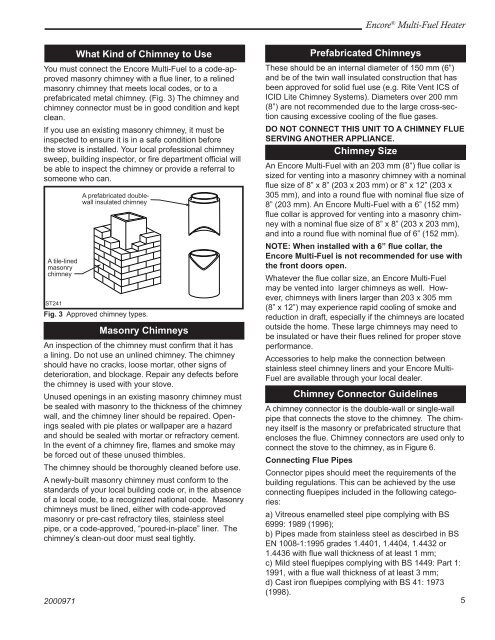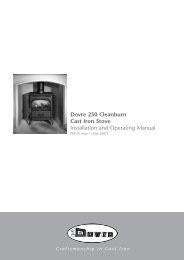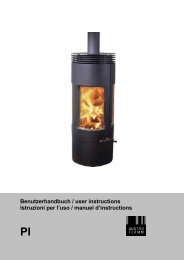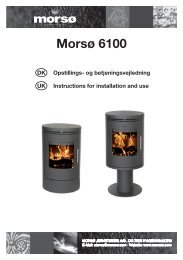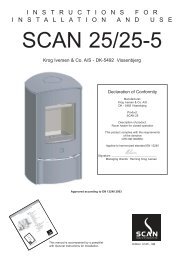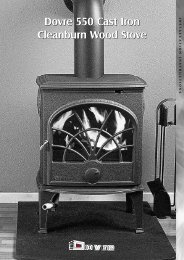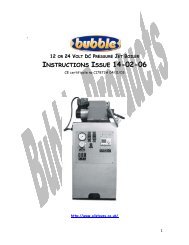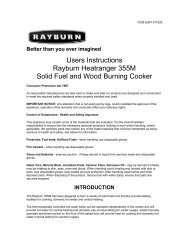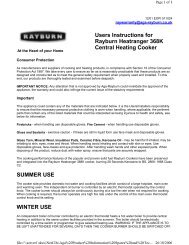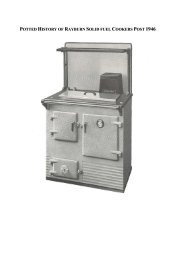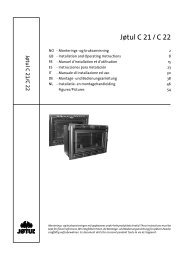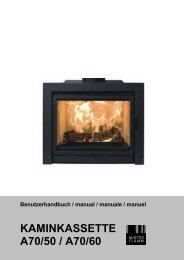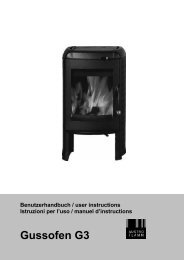Encore®
Encore®
Encore®
Create successful ePaper yourself
Turn your PDF publications into a flip-book with our unique Google optimized e-Paper software.
Encore ® Multi-Fuel HeaterA tile-linedmasonrychimneyST2412000971What Kind of Chimney to UseYou must connect the Encore Multi-Fuel to a code-approvedmasonry chimney with a flue liner, to a relinedmasonry chimney that meets local codes, or to aprefabricated metal chimney. (Fig. 3) The chimney andchimney connector must be in good condition and keptclean.If you use an existing masonry chimney, it must beinspected to ensure it is in a safe condition beforethe stove is installed. Your local professional chimneysweep, building inspector, or fire department official willbe able to inspect the chimney or provide a referral tosomeone who can.A prefabricated doublewallinsulated chimneyFig. 3 Approved chimney types.Masonry ChimneysST241chimney types12/13/99 djtAn inspection of the chimney must confirm that it hasa lining. Do not use an unlined chimney. The chimneyshould have no cracks, loose mortar, other signs ofdeterioration, and blockage. Repair any defects beforethe chimney is used with your stove.Unused openings in an existing masonry chimney mustbe sealed with masonry to the thickness of the chimneywall, and the chimney liner should be repaired. Openingssealed with pie plates or wallpaper are a hazardand should be sealed with mortar or refractory cement.In the event of a chimney fire, flames and smoke maybe forced out of these unused thimbles.The chimney should be thoroughly cleaned before use.A newly-built masonry chimney must conform to thestandards of your local building code or, in the absenceof a local code, to a recognized national code. Masonrychimneys must be lined, either with code-approvedmasonry or pre-cast refractory tiles, stainless steelpipe, or a code-approved, “poured-in-place” liner. Thechimney’s clean-out door must seal tightly.Prefabricated ChimneysThese should be an internal diameter of 150 mm (6”)and be of the twin wall insulated construction that hasbeen approved for solid fuel use (e.g. Rite Vent ICS ofICID Lite Chimney Systems). Diameters over 200 mm(8”) are not recommended due to the large cross-sectioncausing excessive cooling of the flue gases.DO NOT CONNECT THIS UNIT TO A CHIMNEY FLUESERVING ANOTHER APPLIANCE.Chimney SizeAn Encore Multi-Fuel with an 203 mm (8”) flue collar issized for venting into a masonry chimney with a nominalflue size of 8” x 8” (203 x 203 mm) or 8” x 12” (203 x305 mm), and into a round flue with nominal flue size of8” (203 mm). An Encore Multi-Fuel with a 6” (152 mm)flue collar is approved for venting into a masonry chimneywith a nominal flue size of 8” x 8” (203 x 203 mm),and into a round flue with nominal flue of 6” (152 mm).NOTE: When installed with a 6” flue collar, theEncore Multi-Fuel is not recommended for use withthe front doors open.Whatever the flue collar size, an Encore Multi-Fuelmay be vented into larger chimneys as well. However,chimneys with liners larger than 203 x 305 mm(8” x 12”) may experience rapid cooling of smoke andreduction in draft, especially if the chimneys are locatedoutside the home. These large chimneys may need tobe insulated or have their flues relined for proper stoveperformance.Accessories to help make the connection betweenstainless steel chimney liners and your Encore Multi-Fuel are available through your local dealer.Chimney Connector GuidelinesA chimney connector is the double-wall or single-wallpipe that connects the stove to the chimney. The chimneyitself is the masonry or prefabricated structure thatencloses the flue. Chimney connectors are used only toconnect the stove to the chimney, as in Figure 6.Connecting Flue PipesConnector pipes should meet the requirements of thebuilding regulations. This can be achieved by the useconnecting fluepipes included in the following categories:a) Vitreous enamelled steel pipe complying with BS6999: 1989 (1996);b) Pipes made from stainless steel as descirbed in BSEN 1008-1:1995 grades 1.4401, 1.4404, 1.4432 or1.4436 with flue wall thickness of at least 1 mm;c) Mild steel fluepipes complying with BS 1449: Part 1:1991, with a flue wall thickness of at least 3 mm;d) Cast iron fluepipes complying with BS 41: 1973(1998).


